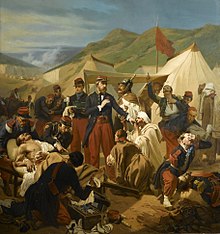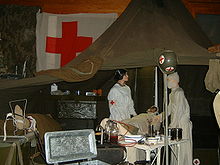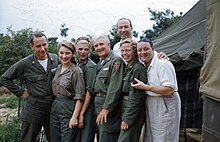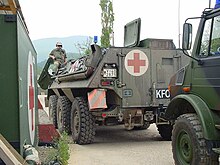
A flight surgeon is a military medical officer practicing in the clinical field of aviation medicine. Although the term "flight surgery" is considered improper by purists, it may occasionally be encountered.

The U.S. Army Medical Command (MEDCOM) is a direct reporting unit of the U.S. Army that formerly provided command and control of the Army's fixed-facility medical, dental, and veterinary treatment facilities, providing preventive care, medical research and development and training institutions. On 1 October 2019, operational and administrative control of all military medical facilities transitioned to the Defense Health Agency.

The Walter Reed Army Medical Center (WRAMC), officially known as Walter Reed General Hospital (WRGH) until 1951, was the U.S. Army's flagship medical center from 1909 to 2011. Located on 113 acres (46 ha) in Washington, D.C., it served more than 150,000 active and retired personnel from all branches of the United States Armed Forces. The center was named after Walter Reed, a U.S. Army physician and sergeant who led the team that confirmed that yellow fever is transmitted by mosquitoes rather than direct physical contact.

Uniformed Services University of the Health Sciences (USU) is a health science university and professional school of the U.S. federal government. The primary mission of the school is to prepare graduates for service to the U.S. at home and abroad as uniformed health professionals, scientists and leaders; by conducting cutting-edge, military-relevant research; by leading the Military Health System in key functional and intellectual areas; and by providing operational support to units around the world.

The United States Navy Nurse Corps was officially established by Congress in 1908; however, unofficially, women had been working as nurses aboard Navy ships and in Navy hospitals for nearly 100 years. The Corps was all-female until 1965.

The Medical Corps of the United States Navy is a staff corps consisting of military physicians in a variety of specialties. It is the senior corps among all staff corps, second in precedence only to line officers. The corps of commissioned officers was founded on March 3, 1871.

The Dental Corps of the United States Navy consists of naval officers with a doctorate in either dental surgery (DDS) or dental medicine (DMD) and who practice dentistry for Sailors and Marines to ensure optimal oral health.

A combat medic is responsible for providing emergency medical treatment at a point of wounding in a combat or training environment, as well as primary care and health protection and evacuation from a point of injury or illness. Additionally, medics may also be responsible for the creation, oversight, and execution of long-term patient care plans in consultation with or in the absence of a readily available doctor or advanced practice provider. Combat medics may be used in hospitals and clinics, where they have the opportunity to work in additional roles, such as operating medical and laboratory equipment and performing and assisting with procedures.
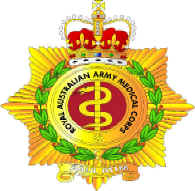
The Royal Australian Army Medical Corps (RAAMC) is the branch of the Australian Army responsible for providing medical care to Army personnel. The AAMC was formed in 1902 through the amalgamation of medical units of the various Australian colonies and was first deployed to South Africa as a small detachment of personnel supporting the Australian Commonwealth Horse during the Second Boer War. The corps has participated in every Australian Army operation since then, including wars and peacekeeping operations. The "Royal" prefix was granted in 1948.
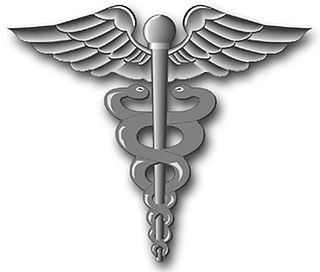
A hospital corpsman is an enlisted medical specialist of the United States Navy, who may also serve in a U.S. Marine Corps unit. The corresponding rating within the United States Coast Guard is health services technician (HS).

The Army Medical Department of the U.S. Army (AMEDD), formerly known as the Army Medical Service (AMS), encompasses the Army's six medical Special Branches. It was established as the "Army Hospital" in July 1775 to coordinate the medical care required by the Continental Army during the Revolutionary War. The AMEDD is led by the Surgeon General of the U.S. Army, a lieutenant general.

Most professional militaries employ specialised military nurses or nursing sisters. They are often organised as a distinct nursing corps. Florence Nightingale formed the first nucleus of a recognised Nursing Service for the British Army during the Crimean War in 1854. In the same theatre of the same war, Professor Nikolai Ivanovich Pirogov and the Grand Duchess Yelena Pavlovna originated Russian traditions of recruiting and training military nurses – associated especially with besieged Sevastopol (1854–1855). Following the war Nightingale fought to institute the employment of women nurses in British military hospitals, and by 1860 she had succeeded in establishing an Army Training School for military nurses at the Royal Victoria Military Hospital in Netley, Hampshire, England.
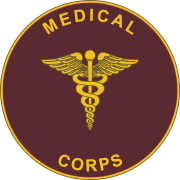
The Medical Corps (MC) of the U.S. Army is a staff corps of the U.S. Army Medical Department (AMEDD) consisting of commissioned medical officers – physicians with either an M.D. or a D.O. degree, at least one year of post-graduate clinical training, and a state medical license.
A medical corps is generally a military branch or officer corps responsible for medical care for serving military personnel. Such officers are typically military physicians.
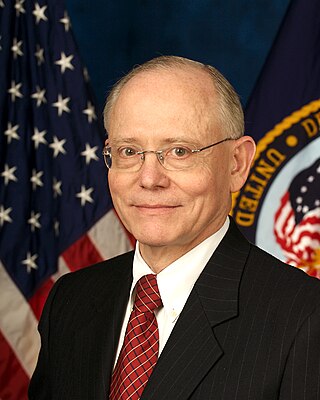
James Benjamin Peake was the sixth United States Secretary of Veterans Affairs, serving from 2007 to 2009. In 2004, he retired from a 38-year United States Army career. He also served as the 40th Surgeon General of the United States Army.
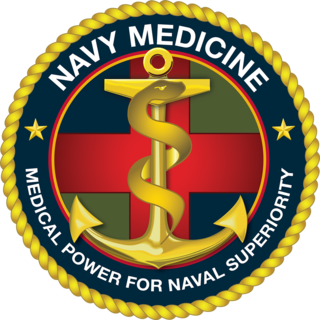
The Bureau of Medicine and Surgery (BUMED) is an agency of the United States Department of the Navy that manages health care activities for the United States Navy and the United States Marine Corps. BUMED operates hospitals and other healthcare facilities as well as laboratories for biomedical research, and trains and manages the Navy's many staff corps related to medicine. Its headquarters is located at the Defense Health Headquarters in Fairfax County, Virginia. BUMED has 41,930 medical personnel and more than a million eligible beneficiaries.

The Army Medical Corps is a specialist corps in the Indian Army, which primarily provides medical services to all Army personnel, serving and veterans, along with their families. Along with the branches in the Indian Navy and Indian Air Force, it forms part of the Armed Forces Medical Services (AFMS). The AFMS consists of around 60,000 personnel.

The recent history of changes in women's roles includes having women in the military. Every country in the world permits the participation of women in the military, in one form or another. In 2018, only two countries conscripted women and men on the same formal conditions: Norway and Sweden. A few other countries have laws conscripting women into their armed forces, however with some difference such as service exemptions, length of service, and more. Some countries do not have conscription, but men and women may serve on a voluntary basis under equal conditions. Alenka Ermenc was the first female head of armed forces in any of the NATO member states, having served as the Chief of the General Staff of the Slovenian Armed Forces between 2018 and 2020.

Rear Admiral Karen Ann Flaherty assumed duties as the Deputy Surgeon General of Navy Medicine at the Bureau of Medicine and Surgery as of August 6, 2010. Flaherty served as the 22nd Director of the United States Navy Nurse Corps as well as the Deputy Chief, Wounded, Ill, and Injured at the Bureau of Medicine and Surgery from 2009 to 2010.

The Swedish Armed Forces Centre for Defence Medicine is a tri-service military medicine center in the Swedish Armed Forces. Its staff is made up of officers, civilian specialists, group commanders and officer reservists – tasked with ensuring care is provided during peacetime, on international missions, at times of crisis and in combat.

